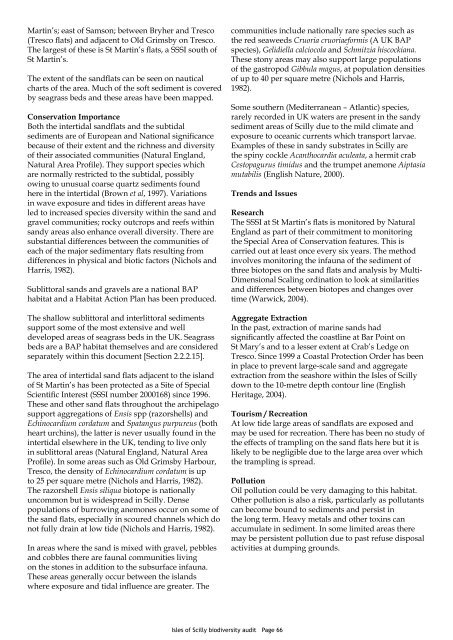The Isles of Scilly Biodiversity Audit 2008 - Cornwall Wildlife Trust
The Isles of Scilly Biodiversity Audit 2008 - Cornwall Wildlife Trust
The Isles of Scilly Biodiversity Audit 2008 - Cornwall Wildlife Trust
Create successful ePaper yourself
Turn your PDF publications into a flip-book with our unique Google optimized e-Paper software.
Martin’s; east <strong>of</strong> Samson; between Bryher and Tresco(Tresco flats) and adjacent to Old Grimsby on Tresco.<strong>The</strong> largest <strong>of</strong> these is St Martin’s flats, a SSSI south <strong>of</strong>St Martin’s.<strong>The</strong> extent <strong>of</strong> the sandflats can be seen on nauticalcharts <strong>of</strong> the area. Much <strong>of</strong> the s<strong>of</strong>t sediment is coveredby seagrass beds and these areas have been mapped.Conservation ImportanceBoth the intertidal sandflats and the subtidalsediments are <strong>of</strong> European and National significancebecause <strong>of</strong> their extent and the richness and diversity<strong>of</strong> their associated communities (Natural England,Natural Area Pr<strong>of</strong>ile). <strong>The</strong>y support species whichare normally restricted to the subtidal, possiblyowing to unusual coarse quartz sediments foundhere in the intertidal (Brown et al, 1997). Variationsin wave exposure and tides in different areas haveled to increased species diversity within the sand andgravel communities; rocky outcrops and reefs withinsandy areas also enhance overall diversity. <strong>The</strong>re aresubstantial differences between the communities <strong>of</strong>each <strong>of</strong> the major sedimentary flats resulting fromdifferences in physical and biotic factors (Nichols andHarris, 1982).Sublittoral sands and gravels are a national BAPhabitat and a Habitat Action Plan has been produced.<strong>The</strong> shallow sublittoral and interlittoral sedimentssupport some <strong>of</strong> the most extensive and welldeveloped areas <strong>of</strong> seagrass beds in the UK. Seagrassbeds are a BAP habitat themselves and are consideredseparately within this document [Section 2.2.2.15].<strong>The</strong> area <strong>of</strong> intertidal sand flats adjacent to the island<strong>of</strong> St Martin’s has been protected as a Site <strong>of</strong> SpecialScientific Interest (SSSI number 2000168) since 1996.<strong>The</strong>se and other sand flats throughout the archipelagosupport aggregations <strong>of</strong> Ensis spp (razorshells) andEchinocardium cordatum and Spatangus purpureus (bothheart urchins), the latter is never usually found in theintertidal elsewhere in the UK, tending to live onlyin sublittoral areas (Natural England, Natural AreaPr<strong>of</strong>ile). In some areas such as Old Grimsby Harbour,Tresco, the density <strong>of</strong> Echinocardium cordatum is upto 25 per square metre (Nichols and Harris, 1982).<strong>The</strong> razorshell Ensis siliqua biotope is nationallyuncommon but is widespread in <strong>Scilly</strong>. Densepopulations <strong>of</strong> burrowing anemones occur on some <strong>of</strong>the sand flats, especially in scoured channels which donot fully drain at low tide (Nichols and Harris, 1982).In areas where the sand is mixed with gravel, pebblesand cobbles there are faunal communities livingon the stones in addition to the subsurface infauna.<strong>The</strong>se areas generally occur between the islandswhere exposure and tidal influence are greater. <strong>The</strong>communities include nationally rare species such asthe red seaweeds Cruoria cruoriaeformis (A UK BAPspecies), Gelidiella calciocola and Schmitzia hiscockiana.<strong>The</strong>se stony areas may also support large populations<strong>of</strong> the gastropod Gibbula magus, at population densities<strong>of</strong> up to 40 per square metre (Nichols and Harris,1982).Some southern (Mediterranean – Atlantic) species,rarely recorded in UK waters are present in the sandysediment areas <strong>of</strong> <strong>Scilly</strong> due to the mild climate andexposure to oceanic currents which transport larvae.Examples <strong>of</strong> these in sandy substrates in <strong>Scilly</strong> arethe spiny cockle Acanthocardia aculeata, a hermit crabCestopagurus timidus and the trumpet anemone Aiptasiamutabilis (English Nature, 2000).Trends and IssuesResearch<strong>The</strong> SSSI at St Martin’s flats is monitored by NaturalEngland as part <strong>of</strong> their commitment to monitoringthe Special Area <strong>of</strong> Conservation features. This iscarried out at least once every six years. <strong>The</strong> methodinvolves monitoring the infauna <strong>of</strong> the sediment <strong>of</strong>three biotopes on the sand flats and analysis by Multi-Dimensional Scaling ordination to look at similaritiesand differences between biotopes and changes overtime (Warwick, 2004).Aggregate ExtractionIn the past, extraction <strong>of</strong> marine sands hadsignificantly affected the coastline at Bar Point onSt Mary’s and to a lesser extent at Crab’s Ledge onTresco. Since 1999 a Coastal Protection Order has beenin place to prevent large-scale sand and aggregateextraction from the seashore within the <strong>Isles</strong> <strong>of</strong> <strong>Scilly</strong>down to the 10-metre depth contour line (EnglishHeritage, 2004).Tourism / RecreationAt low tide large areas <strong>of</strong> sandflats are exposed andmay be used for recreation. <strong>The</strong>re has been no study <strong>of</strong>the effects <strong>of</strong> trampling on the sand flats here but it islikely to be negligible due to the large area over whichthe trampling is spread.PollutionOil pollution could be very damaging to this habitat.Other pollution is also a risk, particularly as pollutantscan become bound to sediments and persist inthe long term. Heavy metals and other toxins canaccumulate in sediment. In some limited areas theremay be persistent pollution due to past refuse disposalactivities at dumping grounds.<strong>Isles</strong> <strong>of</strong> <strong>Scilly</strong> biodiversity audit Page 66
















